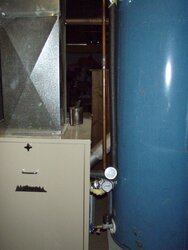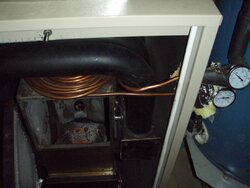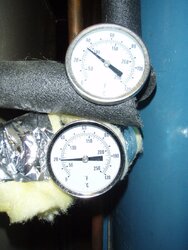have been pre-heating my water for the past 2 years using 60ft of 3/8 copper tubing. works great but i seem to only collect about 50 to 55Deg of heat difference. temps are from the well water going in the coil at 56deg and coming out the end of the coil at 100 to 110.
after a good long fire like when the temps outside are around zero for a few days and the furnace running often the Solar storage tank becomes heated, or at least the water coming from the bottom of the tank is coming out at 70 to 75 deg and the water coming from the end of the coil is about 125 to 130 deg. some im collecting about the same amount of heat from by water coil.
im using the Thermo siphon method. the storage tank is next to, and above the Pellet furnace with the 60ft coil just laying on the top of the burn chamber. does anyone thingk i could collect more of the heat if i covered the coil with Plaster Of Paris? i would make a 1 1/2 inch deep "picture frame" on a flat surface and cover the coil with plaster.
my thinking is the blower that is moving the heated air through out the house is taking some of the heat from the coil. if i cover it it may collect more of the heat in the water.
how do you prepare the Plaster? how do you cure it? is it needed?
would it be worth the effort?
i seen were someone did this to his wood burner so it got me thinking i could gather more heat.
ill post a pic soon.
jim
after a good long fire like when the temps outside are around zero for a few days and the furnace running often the Solar storage tank becomes heated, or at least the water coming from the bottom of the tank is coming out at 70 to 75 deg and the water coming from the end of the coil is about 125 to 130 deg. some im collecting about the same amount of heat from by water coil.
im using the Thermo siphon method. the storage tank is next to, and above the Pellet furnace with the 60ft coil just laying on the top of the burn chamber. does anyone thingk i could collect more of the heat if i covered the coil with Plaster Of Paris? i would make a 1 1/2 inch deep "picture frame" on a flat surface and cover the coil with plaster.
my thinking is the blower that is moving the heated air through out the house is taking some of the heat from the coil. if i cover it it may collect more of the heat in the water.
how do you prepare the Plaster? how do you cure it? is it needed?
would it be worth the effort?
i seen were someone did this to his wood burner so it got me thinking i could gather more heat.
ill post a pic soon.
jim




